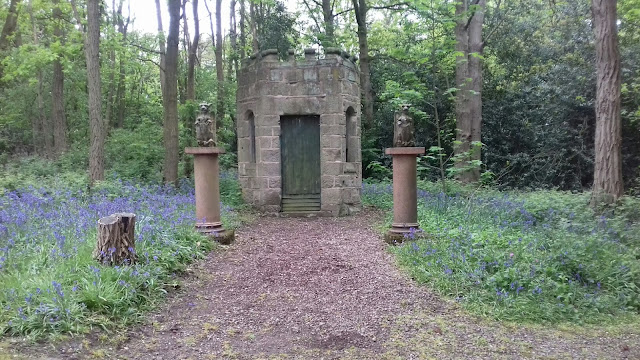Bluebell Spring
 |
Bluebells by the gazebo
|
I love this time of year in the gardens at Betley Court!
Mainly because my favourite flower, the English bluebell is at it’s best. Also,
its flowering coincides with my birthday (which this year was a significant
one. I’m not as old as Betley Court, but I’m half way to a century!). I always
make sure I get a leisurely walk in during Spring just to enjoy the bluebells.
And they are fantastic! One of those glossy, coffee table magazines once
described the bluebell display in Betley Court Gardens as the finest in the
area. High praise indeed!
The bluebells inhabit the wooded area of the gardens. Take
the Long Path down towards the gazebo during April/May-time, and you’ll soon
catch sight of the blue haze they emit. Then, along the path wherever there is
a pool of light under the trees, there’ll be a drift of bluebells. This extends
right around the valley that Tanhouse Brook sits in, so at this time of year it
is really a sight to behold. Of course, this association with broadleaf
woodland, as we have at Betley Court, is the secret of the English bluebell’s success.
Bluebells make use of a short period of time, when the lengthening days warm
the soil, but the deciduous trees have not yet fully come into leaf to flower
and complete their reproductive cycle. Once the trees are in full leaf, it is
too shaded and too warm for bluebells to thrive, so they retreat into their
bulbs in the soil and wait for Spring.
English bluebells also enjoy a symbiotic relationship with
the mycorisi (tiny threadlike fungus) that inhabit the soil around broadleaf
trees. This is why it’s pointless to dig up wild bluebells and plant them in
you garden. They will shrivel up and die, unless your soil also enjoys a
similar fungus population to the site you took the bulbs from. But of course, any
decent law-abiding person wouldn’t dig them up anyway, as they are a protected
species of wildflower under UK law.
English bluebells were first described by the famous Swedish
botanist Carl Linneaus in 1753, a good 30 years before William Emes started
work on the grounds at Betley Court. Linneaus gave them the Latin binomial name of Hyacinthoides non scripta. The ‘Hyacinthoides’ meaning ‘like a hyacinth’
and the non scripta meaning ‘unmarked’,
although some translations describe it as ‘common’. I take it to mean ‘like a
hyacinth, but not a hyacinth’, which seem to fit it well.
Of course, the bluebell is not the only flower of the
moment. To the left of the Long Path, our celebrity tree, as mentioned on
Gardeners Question Time, the Helesia carolina (snowdrop tree) is in full
flower, despite it’s agedness. And down in the Dingle, by the bridge across Tanhouse
Brook, we have a lovely display of Allium ursinum or ransomes/wild garlic, if
you prefer? They have such pretty white flowers at this time of year, but oh,
the pungent garlic-y smell if they are trampled. Best viewed from a distance.
Or if you must get close, grab a handful, they are excellent as an ingredient
where garlic is called for.
 |
| Helesia Carolina (Snowdrop tree) |
 |
| Wild garlic or ransomes |
Happy gardening, wherever you are.
Ladybird Su





Comments
Post a Comment